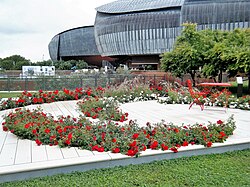Parco della Musica
 View of terrace outside the venue (c.2016) | |
 | |
| Address | Via Pietro de Coubertin, 30 00196 Rome RM Italy |
|---|---|
| Location | Parioli |
| Owner | Comune di Roma |
| Capacity | 2,744 (Sala Santa Cecilia) 2,707 (Cavea) 1,133 (Sala Sinopoli) 661 (Sala Petrassi) 304 (Teatro Studio Borgna) |
| Construction | |
| Broke ground | 15 January 1995 |
| Opened | 21 April 2002 |
| Architect | RPBW Architects |
| Structural engineer | Studio Vitone & Associati |
| Services engineer | Manens Intertecnica |
| General contractor | Techint |
| Website | |
| Venue Website | |
Building details | |
| General information | |
| Inaugurated | 21 December 2002 |
| Design and construction | |
| Developer | Drees & Sommer |
| Other designers |
|
| Quantity surveyor | Davis Langdon |
The Auditorium Parco della Musica is a large public music complex in Rome, Italy, with three indoor concert halls and an outdoor theater in a park setting, hence its name. It was designed by Italian architect Renzo Piano[1]; Jürgen Reinhold of Müller-BBM was in charge of acoustics in the three concert halls; Franco Zagari was landscape architect for the outdoor spaces. Parco della Musica lies somewhat north of Rome’s ancient city center, where the 1960 Summer Olympic Games were held, and is home to the world-famous Accademia Nazionale di Santa Cecilia.
The halls are Sala Santa Cecilia, with about 2800 seats; Sala Sinopoli, in memory of conductor Giuseppe Sinopoli, seating about 1200 people; and Sala Petrassi, in memory of Goffredo Petrassi, with 700 seats. Structurally separated for sound-proofing, they are nonetheless joined at the base by a continuous lobby. (Collectively they have acquired nicknames, such as “the blobs,” “the beetles,” “the turtles,” and “the computer mice”.[1]) The outdoor theater, called the Cavea, recalls ancient Greek and Roman performance spaces.[1] The complex has a fan-shaped layout around its central piazza.
During construction, excavations uncovered the foundations of a villa and an oil-press dating from the 6th century BC. Renzo Piano then adjusted his design scheme to accommodate the archaeological remains and included a small museum to house artifacts discovered, delaying the project’s completion by a year.[1] Parco della Musica was inaugurated on 21 December 2002. Within a few years it became Europe’s most-visited music facility.[2] In 2014 it had over two million visitors, making it the second-most-visited cultural music venue in the world, after Lincoln Center in New York.
References
External links
41°55′45″N 12°28′28″E / 41.929075°N 12.474557°E
- 2002 establishments in Italy
- Buildings and structures in Rome
- Accademia Nazionale di Santa Cecilia
- Concert halls in Italy
- Music venues completed in 2002
- Music venues in Italy
- Renzo Piano buildings
- Rome Q. II Parioli
- Theatres in Rome
- Theatres completed in 2002
- Tourist attractions in Rome
- Italian building and structure stubs
